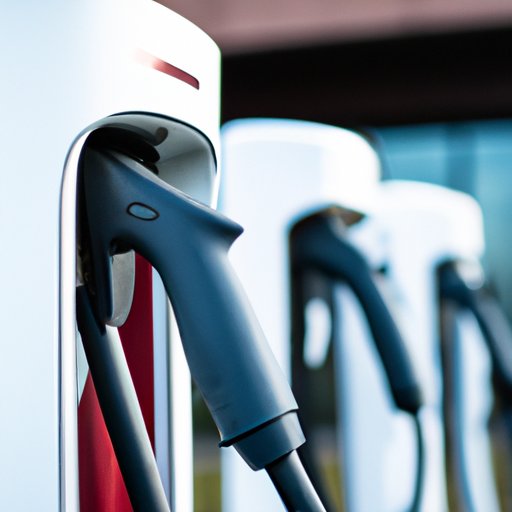Introduction
Electric cars are the future, and Tesla’s popularity continues to grow. Charging your Tesla is an essential aspect of ownership, and it’s essential to know how to do it efficiently and correctly to maximize your Tesla’s range. This article will provide a comprehensive guide to charging your Tesla, providing step-by-step instructions and tips to ensure a smooth charging experience.
Step-by-Step Guide
The first step to charging your Tesla is choosing the right charger. Your Tesla will come with a mobile charger that can be plugged into any regular outlet, but this is the slowest method of charging. Alternatively, you can install a 240-volt charging station at home for faster charging times. If you are traveling, you can use one of the many supercharger or third-party charging stations available on highways and in urban areas.
Before you start charging, make sure you have the appropriate equipment. This includes your Tesla’s charging adapter, a charging cable, and, if necessary, an adapter to convert from the station’s outlet. Once you’ve found the charger, plug in your charging cable, and your Tesla will automatically start charging.
Planning Your Route
When planning your route with a Tesla, it’s essential to consider charging times. Several mobile and web apps allow you to map out your trip and find charging stations along the way, such as Tesla’s built-in Trip Planner or popular apps like PlugShare and ChargePoint. To minimize charging time, plan efficient routes that stop at charging stations long enough to replenish your battery adequately. If taking a long-distance trip, keep in mind that Tesla’s superchargers are typically located near highways and urban centers to provide quick charging options for travelers.
Charging at Home
Charging at home is the most convenient way to charge your Tesla, and it ensures that your vehicle is always ready for use. Installation of a home charging station typically involves hiring an electrician to run a dedicated circuit and mount the charging station. Proper installation ensures both safety and optimal charging performance. If you are renting a property, check your lease agreement to see if you are allowed to install a charging station.
It’s also essential to maintain your home charging station to keep it in top working condition. This includes keeping it clean, ensuring that the charging cable is properly stored, and checking for any signs of wear and tear. Regular maintenance will help ensure that your home charging station continues to provide efficient charging for years to come.
Maximizing Your Range
Driving an electric car is all about maximizing your range, and there are several tips and tricks to help you do so. For example, using energy-efficient driving modes can help extend your Tesla’s range. Regenerative braking is another feature that can help conserve energy by recovering energy that’s normally lost when braking.
You can also reduce your need for frequent charging by making small adjustments to your driving habits. For example, avoiding sudden stops and starts will help conserve your battery’s energy. Similarly, reducing your speed and using your vehicle’s energy-saving features like cruise control can help you maximize your range.
Charging on the Go
When you are out and about, charging your Tesla is still possible, thanks to the various charging station options available. Tesla’s supercharging network and third-party charging stations provide fast and convenient charging options that can help you get back on the road quickly. Still, it’s essential to keep an eye on your battery level and plan your route accordingly.
It’s also crucial to know the difference between charging stations, superchargers, and third-party chargers. Every charging station has different power levels, so it’s essential to know which one is compatible with your vehicle. Superchargers are Tesla’s proprietary fast-charging solutions, which are only available to Tesla drivers. Third-party chargers, on the other hand, may vary in quality and speed, so it’s essential to research and choose wisely.
Troubleshooting
Despite the many advantages of owning a Tesla, charging-related issues can sometimes occur. Common problems include slow charging, error messages, or charging interruptions. Sometimes, these issues can be resolved by simply unplugging and plugging back in your charger. If the problem continues, you may need to consult your owner’s manual, Tesla app, or seek professional assistance from Tesla’s service department or a certified electrician.
Best Practices
To maintain your battery’s lifespan, it’s essential to follow best practices when charging your Tesla. Proper temperature control and avoiding overcharging or undercharging are critical factors to consider. For example, charging your Tesla in extreme temperatures (below 32°F or above 90°F) can damage your battery’s health over time. Similarly, overcharging or undercharging can lead to premature battery degradation.
It’s also essential to use reliable charging equipment, keep your battery within a moderate temperature range, and avoiding any extreme or erratic driving behavior that may impact your battery’s lifespan.
Conclusion
Charging your Tesla is a significant and necessary aspect of owning an electric vehicle. By following the tips and advice outlined in this article, you can ensure a smooth charging experience and maintain your battery’s lifespan. Plan your route with charging times in mind, maintain your home charging station, and follow proper charging practices to maximize your Tesla’s range and ensure stress-free travel.
